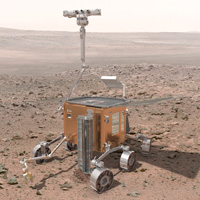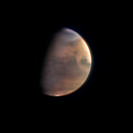Green light awaited for Europe's Mars mission
5 March 2008
The cornerstone of ESA's Aurora exploration programme is ExoMars, a mission to deliver Europe's first planetary rover to the Red Planet. After more than a year of studying various mission concepts, the ExoMars team is preparing to move on to the detailed design of the ExoMars spacecraft and rover."ExoMars has evolved since first proposed in 2005 into a major Mars exploration mission with more than double the initial payload of scientific instruments. We have now selected the baseline configuration and are ready to move on to the next stage, known as Phase B2," said Don McCoy, ESA's ExoMars project manager. "Over the coming weeks we will prepare our proposals for the implementation of the next phase, and these will be presented to the Human Spaceflight, Microgravity and Exploration Programme Board in late November."
 |
|
ExoMars rover - phase B1 concept |
The chosen baseline mission envisages the delivery of the ExoMars rover and landing station to the surface of Mars. Currently scheduled for an Ariane-5 ECA launch from Kourou in 2013, the five tonne spacecraft will take 9 – 10 months to arrive at Mars.
After spending several months in orbit around the planet to ensure that its mission will not be disrupted by the Martian dust storm season, the spacecraft will head towards the surface, protected by a heat-resistant aeroshell. The final stages of the descent will require the deployment of large parachutes, followed by inflation of a vented airbag that will cushion the landing.
 |
|
Planet Mars |
"We have not yet selected a landing site, but we anticipate that ExoMars will touch down fairly near the equator, between 10 degrees South and 35 degrees North," said Don McCoy.
Once the airbags deflate and the petals of the landing stage open out, the rover will be able to begin its six-month exploration of Mars. Fed by daily instructions from Earth, the 'intelligent', solar powered vehicle will use information from its stereo cameras to make its way from target to target, travelling up to 1 km during each Martian day.
As its six independently powered wheels leave their tracks in the rust-red dust, the rover’s Pasteur payload of 11 scientific instruments will search for signs of life – past or present – and investigate the alien environment. One of the most valuable tools will be a drill that can penetrate to a depth of two metres. Soil samples retrieved by the drill will be crushed and distributed to the onboard experiments for chemical analysis.
Further information of value to scientists will be sent back by the Geophysical and Environmental Payload on the landing stage. The lander's instruments will include a weather station, a subsurface radar, a seismometer, a mole and a radio experiment to study tiny variations in the motion of Mars.
The prime contractor for the ExoMars spacecraft will be Thales Alenia Space of Turin, Italy. Prime contractor for the rover will be Astrium UK, while development of the landing stage will be led by Astrium Gmbh of Germany.
International partners will contribute to the ExoMars mission in several ways. In addition to providing some of the scientific instruments, the United States will ensure communication links with Earth via one or more NASA satellites in orbit around Mars. Discussions are also under way regarding co-operation with Russia, which has announced its intention to send the Phobos-Grunt mission to Mars in 2009.
